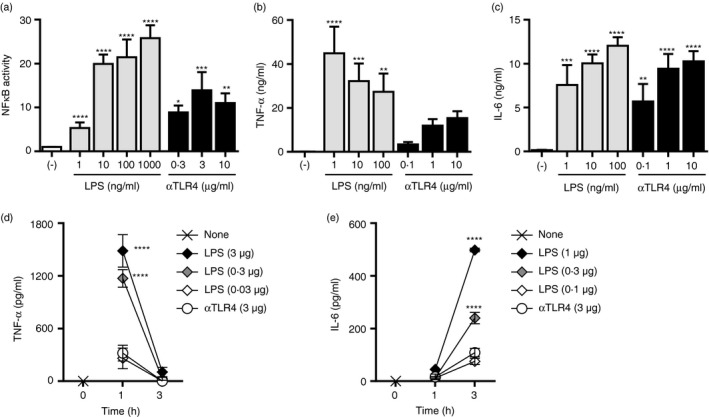Figure 6.

The agonistic anti‐Toll‐like receptor 4 (TLR4) monoclonal antibody (mAb) induces an inflammatory reaction of lesser magnitude than does lipopolysaccharide (LPS). (a) Mouse TLR4/MD‐2‐expressing Ba/F3‐transfected cells carrying NF‐κB‐responsive luciferase reporter genes were stimulated with the anti‐TLR4 mAb or LPS at the indicated concentrations for 5–7 hr. Luciferase activities are shown as mean ± SD fold increases of triplicate cultures compared with non‐stimulated cells. One‐way ANOVA with the Tukey post hoc test; *P < 0·05, **P < 0·01, ***P < 0·001, ****P < 0·0001 (versus the control). Data are representative of three independent experiments. (b, c) Bone marrow‐derived macrophages (BMMs) were stimulated with the anti‐TLR4 mAb or LPS at the indicated concentrations for 24 hr. The concentrations of (b) TNF‐α and (c) IL‐6 in the culture supernatants were evaluated by ELISA. One‐way ANOVA with the Tukey post hoc test; **P < 0·01, ***P < 0·001, ****P < 0·0001 (versus the control). Data are means ± SDs of triplicate cultures and are representative of three independent experiments. (d, e) The mice (n = 3 per group) were administered the anti‐TLR4 mAb or LPS i.p. One or three hours later, plasma was collected, and the concentrations of (d) TNF‐α and (e) IL‐6 were determined by ELISA. Two‐way ANOVA with the Tukey post hoc test; ****P < 0·0001 (versus the anti‐TLR4 mAb). Data are means ± SEMs of two independent experiments.
